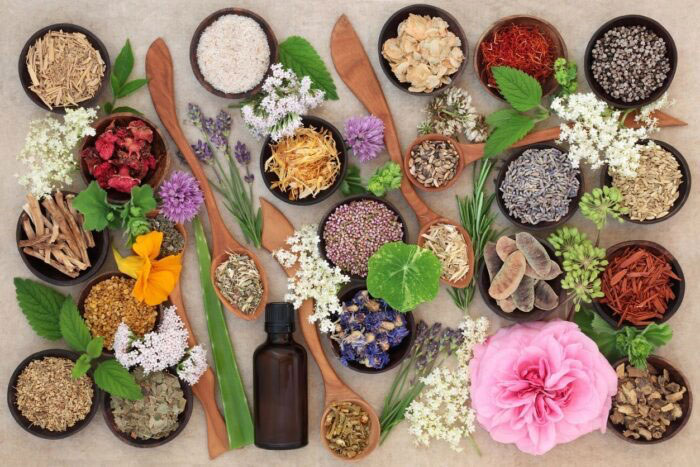Tinctures 101


Think of tinctures as basically herbal tea on steroids. You get a strong dose of the healing powers of plants in a tiny amount. Tinctures are assimilate well, especially if you can stand to put them, straight, under your tongue for a few moments. And tinctures made using alcohol preserve active plant constituents. Alcohol based tinctures last for years when stored in a cool dark place. No refrigeration is necessary for alcohol based tinctures and they are convenient for travel.
Herbal tinctures are concentrated herbal extracts made by soaking either fresh or dried, bark, berries, leaves, flowers, or roots from one or more plants in a liquid combination of alcohol and water. This liquid solvent is called the menstruum. The alcohol pulls out or extracts the active and therapeutic properties for the plants, the alkaloids, the vitamins, and minerals.
Tinctures are easier to use and easier to administer. You only have to take a small amount (A dropper of tincture equals one 8 oz. cup of tea) directly under the tongue and it will enter the bloodstream faster than any other herbal form. Some herbs may have an immediate effect, like relaxant herbs, while the more nutritive and building herbs, (think of them as multi-vitamin), may take several weeks of continual use for optimal results.
A tincture is a more concentrated form of herbal medicine, made by combining one part herb with one part fluid, for example, 250 grams of herb to 250 ml. of alcohol. The ratio of fluid to herb for tinctures varies from 2:1 (i.e. 2 parts fluid to one part herb) to 8:1, depending on the herb and the manufacturing source. The lower the number, the higher the ratio of herb to fluid.
Alcohol is the most traditional way of making tinctures for two reasons. It acts as an effective preservative and it has a very long shelf life. The alcohol in one dose of an alcohol-based tincture has approximately the same alcohol content as a very ripe banana peel. That translates to one drink, one glass of wine or one beer, if you drank and entire 1oz bottle of tincture in one sitting (this is not recommended). Taking the recommended dosage the alcohol content is negligible.
But herbs can also be extracted in vegetable glycerin or apple cider vinegar, ACV, to eliminate alcohol from the formula and, sometimes, to improve the efficacy of certain herbs (like mushrooms in ACV), as well. Tinctures made of vegetable glycerin have a sweet taste and are a great choice for those who prefer a non-alcohol product. They have a shorter shelf life, but can still last 3-5 years, if not contaminated. Always store your tinctures, even kitchen herbs, in a cool, dark location because keeping them in a heated area can cause your herbs and spices to become weak and less effective.
Herbal tinctures are often strong tasting, particularly alcohol based tinctures, and you might feel a subtle heat sensation. Don’t swallow the tincture immediately, but rather keep it under your tongue for a few seconds, then swallow as normal. You will likely become accustomed to both the taste and the sensation over time, but if not, you can dilute the tincture in a small amount of water or juice and drink. You can also add your drops of tincture into a cup of warm or hot water to create a cup of herbal tea. Always warm your water before adding the herbs to preserve their efficacy. Avoid liquids and food for at least 15 minutes after taking tinctures for the best results.
Tinctures are very personalized. And with hundreds of tinctures to explore, it is important to remember that each body responds differently to herbs. Always be mindful and stay attuned to your symptoms and their progress. Listen to your body and always talk with your primary health care provider if you feel like you need to change your herbs or your dosage to create an herbal plan that best fits your needs.
Tinctures are a great way make sure you stay on your regimen when traveling or keeping a busy schedule. TSA limits liquid carry-ons at 3 ounces, but you can rebottle your larger tinctures into 2-ounce labeled bottles, making it easier to keep bottles in various locations, as well, i.e. office, home or purse.
Because tinctures are a concentrate, you only need a very small dose. Some can be taken up to 3 times a day. Always follow the dosing directions on the packaging and consult your primary health care giver before use, or if you are pregnant, nursing, or have any other health condition. Here is a chart to help you determine dosage and use.
HOW LONG WILL IT LAST
1 drop = 26 mg, 38 drops = 1 gram, 1cc =37 40 drops
2 ounces = 200 drops* = 1000 (500 mg) capsules
2 ounces = 80 squirts, 1 squirt = 25 drops
| Taken 1 time/day | 6 drops = 333 days | 12 drops = 166 days |
| Taken 2 times/day | 6 drops = 167 days | 12 drops = 83 days |
| Taken 3 times/day | 6 drops = 111 days | 12 drops = 55 days |
| Taken 4 times/day | 6 drops = 83 days | 12 drops = 41 days |
General Suggested Dosage or Use: 6-12 drops or more in juice, water, under the tongue or as desired. May be taken 3 times or more daily. Shake well. Store in cool dark place. Keep out of reach of children.
Expiration date: Approx. 10 years or more for alcohol based tinctures and 3 years or more for glycerin or vinegar based tinctures

Comments are closed here.